一、Xmind整理: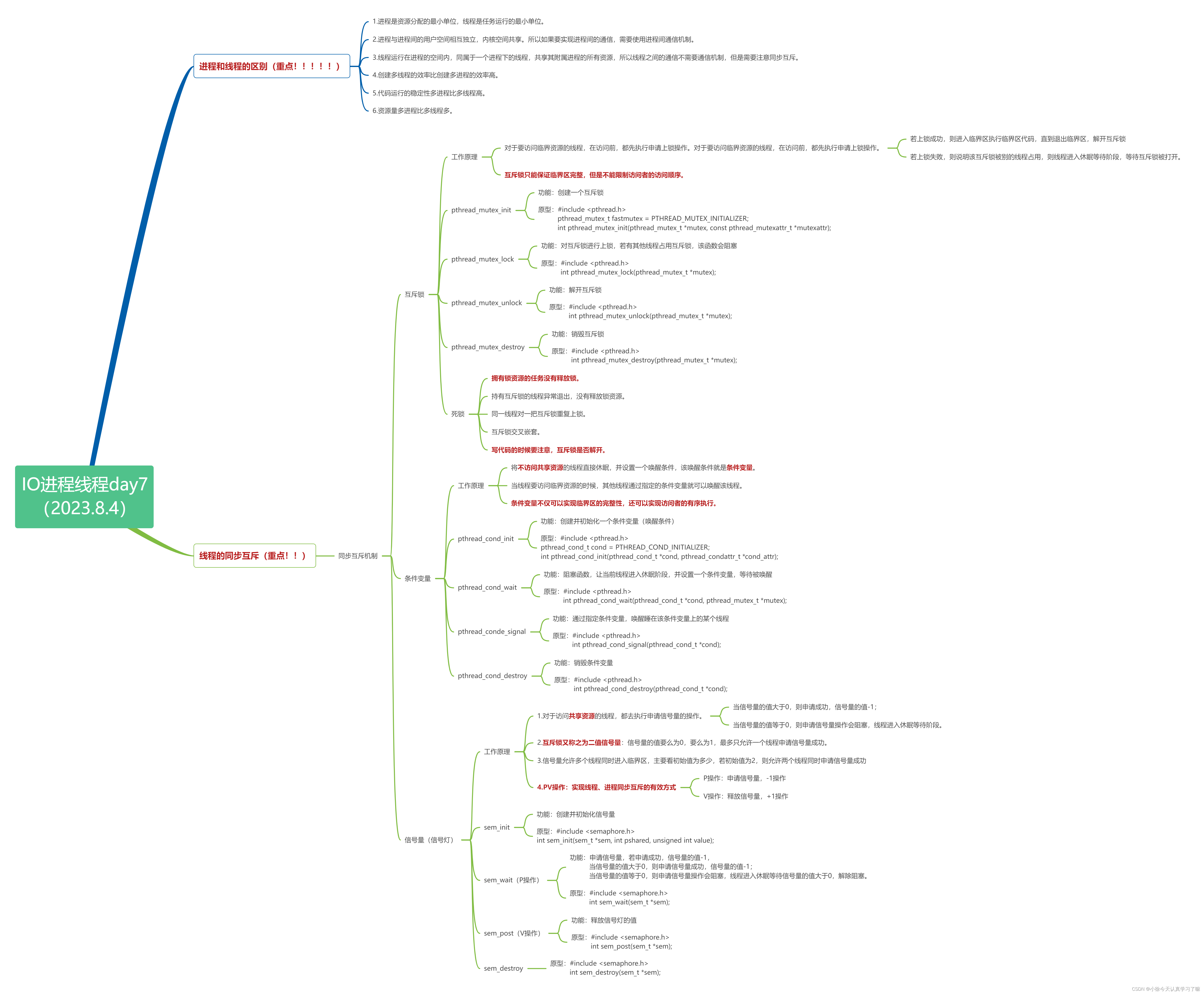
二、课上练习:
练习1:创建两个线程:其中一个线程拷贝前半部分,另一个线程拷贝后半部分。
只允许开一份资源,且用互斥锁方式实现。 提示:找临界区--->找临界资源。
#include <stdio.h>
#include <sys/stat.h>
#include <sys/types.h>
#include <fcntl.h>
#include <unistd.h>
#include <head.h>
#include <pthread.h>//定义一个结构体,传入到线程中
struct Msg
{int fd_r;int fd_w;off_t size;
};//定义互斥锁
pthread_mutex_t mutex = PTHREAD_MUTEX_INITIALIZER;//拷贝前半部分
void* callBack1(void* arg) //void* arg = &fileinfo
{int fd_r = ((struct Msg*)arg)->fd_r;int fd_w = ((struct Msg*)arg)->fd_w;off_t size = ((struct Msg*)arg)->size;//修改文件偏移量到文件开头位置off_t offset = 0;char c = 0;for(int i = 0; i<size/2; i++){/*********临界区****************/pthread_mutex_lock(&mutex); //上锁lseek(fd_r, offset, SEEK_SET);lseek(fd_w, offset, SEEK_SET);read(fd_r, &c, 1);write(fd_w, &c, 1);offset = lseek(fd_r, 0, SEEK_CUR);pthread_mutex_unlock(&mutex); //解锁/*********临界区****************/}printf("前半部分拷贝完毕\n");pthread_exit(NULL);
}//拷贝后半部分
void* callBack2(void* arg) //void* arg = &fileinfo
{int fd_r = ((struct Msg*)arg)->fd_r;int fd_w = ((struct Msg*)arg)->fd_w;off_t size = ((struct Msg*)arg)->size;//修改文件偏移量到sizee/2位置off_t offset = size/2;char c = 0;for(int i = size/2; i<size; i++){/*********临界区****************/pthread_mutex_lock(&mutex); //上锁lseek(fd_r, offset, SEEK_SET);lseek(fd_w, offset, SEEK_SET);read(fd_r, &c, 1);write(fd_w, &c, 1);offset = lseek(fd_r, 0, SEEK_CUR);pthread_mutex_unlock(&mutex); //解锁/*********临界区****************/}printf("后半部分拷贝完毕\n");pthread_exit(NULL);
}int main(int argc, const char *argv[])
{//以读的方式打开源文件int fd_r = open("./1.png", O_RDONLY);if(fd_r < 0){ERR_MSG("open");return -1;}//以写的方式打开目标文件int fd_w = open("./copy.png", O_WRONLY|O_CREAT|O_TRUNC, 0664);if(fd_w < 0){ERR_MSG("open");return -1;}off_t size = lseek(fd_r, 0, SEEK_END);struct Msg fileinfo;fileinfo.fd_r = fd_r;fileinfo.fd_w = fd_w;fileinfo.size = size;//创建一个线程pthread_t tid1, tid2;if(pthread_create(&tid1, NULL, callBack1, &fileinfo) != 0){fprintf(stderr, "pthread_create failed __%d__\n", __LINE__);return -1;} if(pthread_create(&tid2, NULL, callBack2, &fileinfo) != 0){fprintf(stderr, "pthread_create failed __%d__\n", __LINE__);return -1;}//阻塞等待分支线程退出pthread_join(tid2, NULL);pthread_join(tid1, NULL);//销毁互斥锁pthread_mutex_destroy(&mutex);//关闭文件close(fd_r);close(fd_w);return 0;
}
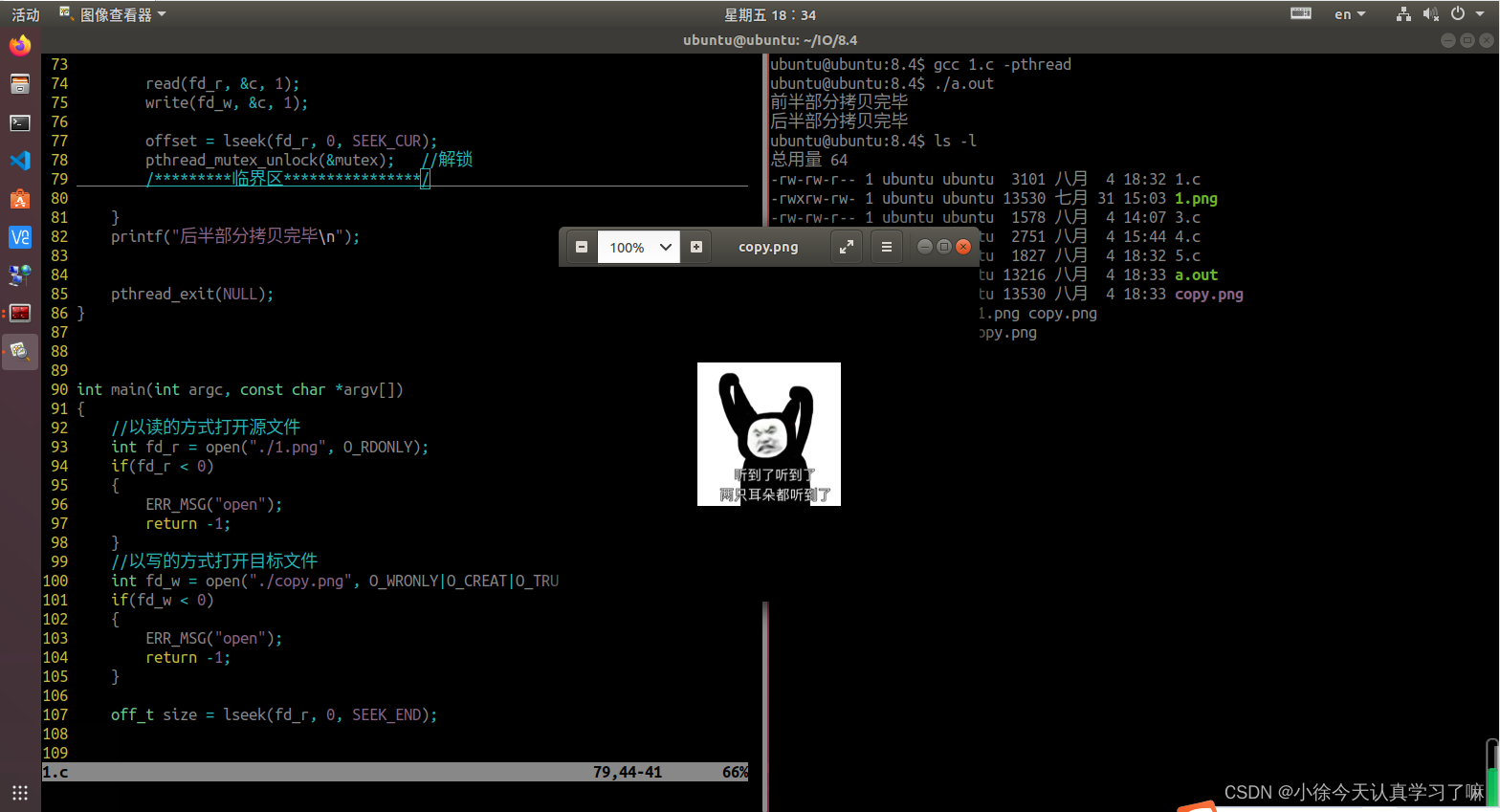
练习2:sem_init
功能:创建并初始化信号量
原型:
#include <semaphore.h>
int sem_init(sem_t *sem, int pshared, unsigned int value);参数:
sem_t *sem:存储申请后的信号量;
int pshared:共享标识
0:信号量用于同一个进程下的线程的同步互斥;
非0:用于进程间的同步互斥机制;
unsigned int value:信号量的初始值;返回值:
成功,返回0;
失败,返回-1,更新errno;练习3:sem_wait(P操作)
功能:申请信号量,若申请成功,信号量的值-1
当信号量的值大于0,则申请信号量成功,信号量的值-1;
当信号量的值等于0,则申请信号量操作会阻塞,线程进入休眠等待信号量的值大于0,解除阻塞。
原型:
#include <semaphore.h>
int sem_wait(sem_t *sem);参数:
sem_t *sem:指定要操作哪个信号灯;返回值:
成功,返回0;
失败,返回-1,更新errno;练习4:sem_post(V操作)
功能:释放信号灯的值
原型:
#include <semaphore.h>
int sem_post(sem_t *sem);返回值:
成功,返回0;失败,返回-1,更新errno;练习5:sem_destroy
原型:
#include <semaphore.h>
int sem_destroy(sem_t *sem);小练:
#include <stdio.h>
#include <string.h>
#include <stdlib.h>
#include <head.h>
#include <pthread.h>
#include <semaphore.h>
void* CallBack(void* arg) //void* arg = &sem;
{sleep(3);//V操作if(sem_post((sem_t*)arg)<0){perror("sem_post");return NULL;}printf("V operation success __%d__\n",__LINE__);pthread_exit(NULL);
}int main(int argc, const char *argv[])
{sem_t sem;if(sem_init(&sem,0,2)<0){perror("sem_init");return -1;}printf("sem_init success __%d__\n",__LINE__);//创建一个线程,3s后V一次pthread_t tid;if(pthread_create(&tid,NULL,CallBack,(void*)&sem) != 0){fprintf(stderr,"pthread_create failed:__%d__\n",__LINE__);return -1;}//P操作 if(sem_wait(&sem)<0){perror("sem_wait");return -1;}printf("P operation success __%d__\n",__LINE__);//P操作if(sem_wait(&sem)<0){perror("sem_wait");return -1;}printf("P operation success __%d__\n",__LINE__);//P操作if(sem_wait(&sem)<0){perror("sem_wait");return -1;}printf("P operation success __%d__\n",__LINE__);pthread_join(tid,NULL);sem_destroy(&sem);return 0;
}
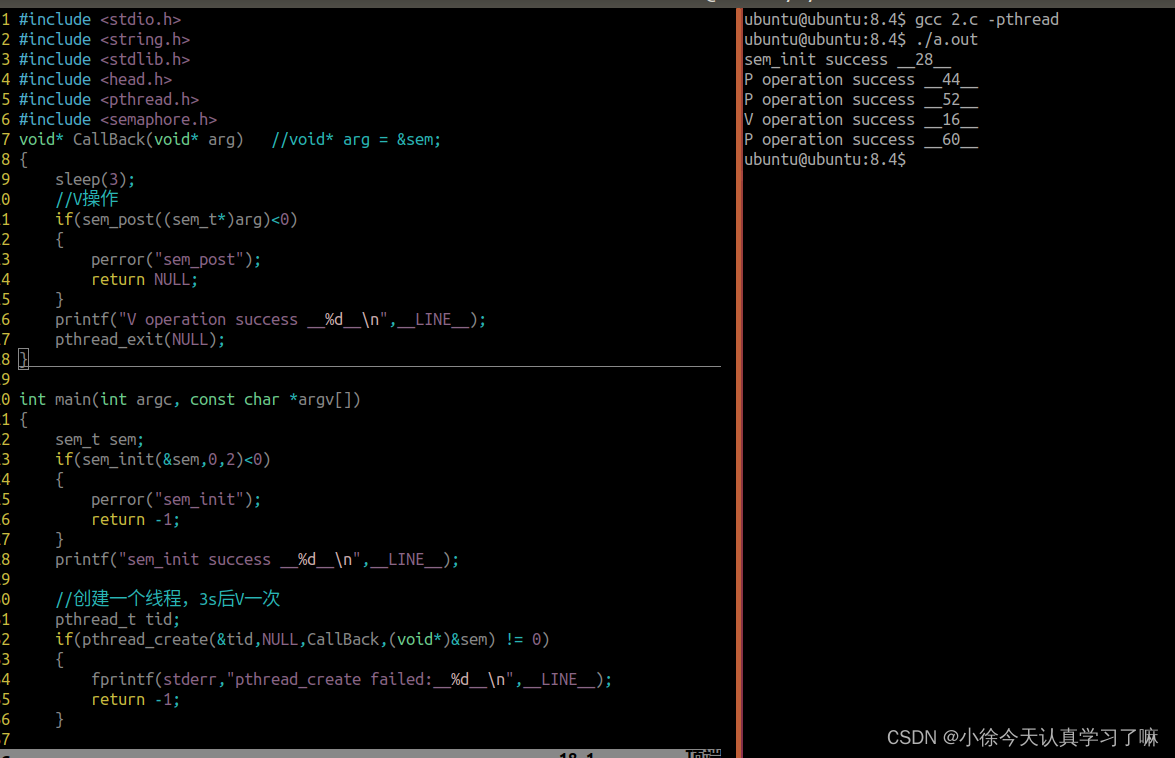
练习6:先打印1234567,后打印7654321
#include <stdio.h>
#include <string.h>
#include <stdlib.h>
#include <head.h>
#include <pthread.h>
#include <semaphore.h>
//临界资源
char buf[]="1234567";void* CallBack1(void* arg)
{while(1){/**********临界区*********///p操作if(sem_wait((sem_t*)arg)<0){perror("sem_wait");return NULL;}printf("%s\n",buf);//v操作if(sem_post((sem_t*)arg)<0){perror("sem_post");return NULL;}/**********临界区*********/}pthread_exit(NULL);
}
void* CallBack2(void* arg)
{char tmp=0;while(1){/**********临界区*********///p操作if(sem_wait((sem_t*)arg)<0){perror("sem_wait");return NULL;}for(int i=0;i<strlen(buf)/2;i++){tmp=buf[i];buf[i]=buf[strlen(buf)-1-i];buf[strlen(buf)-1-i]=tmp;}//v操作if(sem_post((sem_t*)arg)<0){perror("sem_post");return NULL;}/**********临界区*********/}pthread_exit(NULL);
}
int main(int argc, const char *argv[])
{sem_t sem;if(sem_init(&sem,0,1)<0){perror("sem_init");return -1;}printf("sem_init success __%d__\n",__LINE__);//创建线程pthread_t tid1,tid2;if(pthread_create(&tid1,NULL,CallBack1,(void*)&sem) != 0){fprintf(stderr,"pthread_create failed:__%d__\n",__LINE__);return -1;}pthread_detach(tid1); //分离线程1if(pthread_create(&tid2,NULL,CallBack2,(void*)&sem) != 0){fprintf(stderr,"pthread_create failed:__%d__\n",__LINE__);return -1;}pthread_join(tid2,NULL); //阻塞等待线程2退出//销毁信号量sem_destroy(&sem);return 0;
}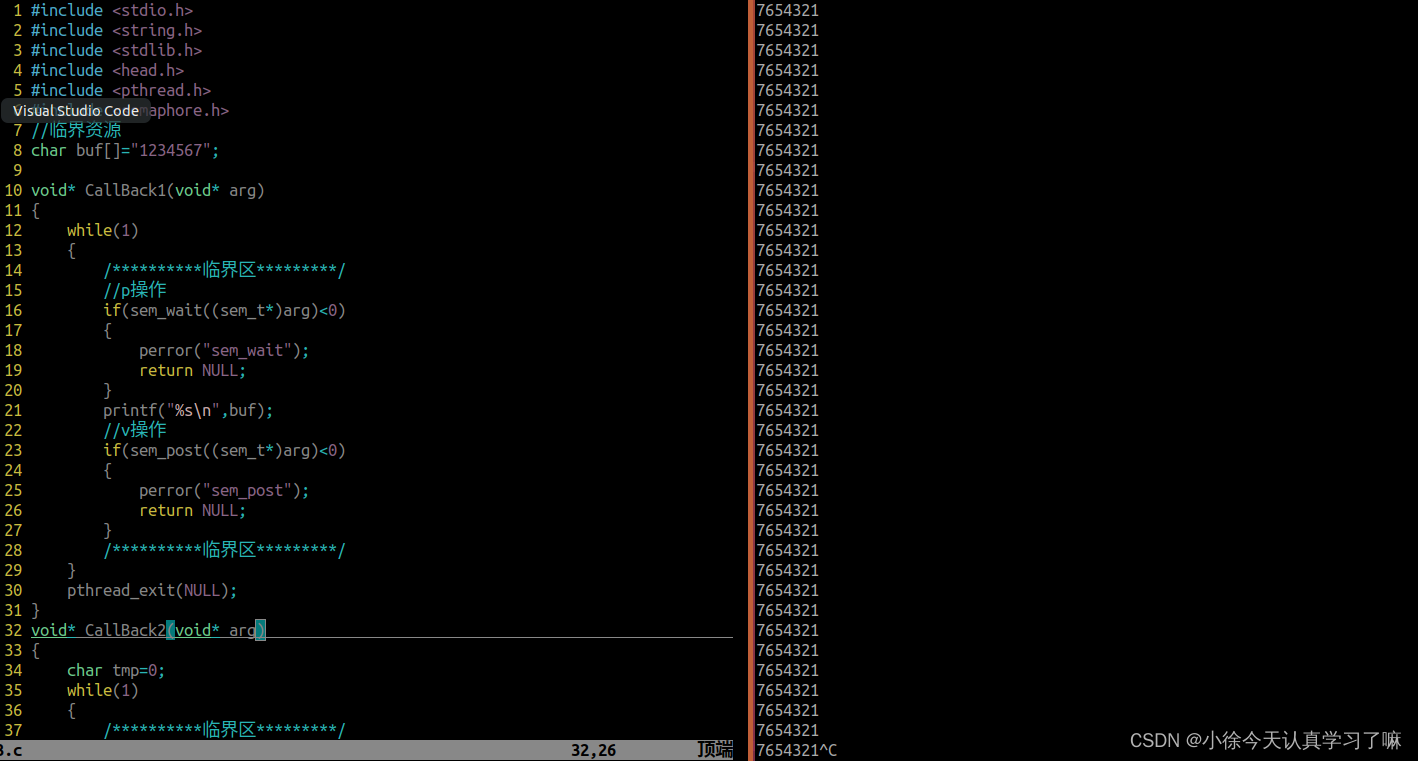
练习7:pthread_cond_init
功能:创建并初始化一个条件变量(唤醒条件)
原型:
#include <pthread.h>
pthread_cond_t cond = PTHREAD_COND_INITIALIZER;
int pthread_cond_init(pthread_cond_t *cond, pthread_condattr_t *cond_attr);参数:
pthread_cond_t *cond:指定存储创建并初始化后的条件变量;
pthread_condattr_t *cond_attr:条件变量属性,设置条件变量适用于进程间还是线程间的同步互斥。填NULL,默认属性,用于线程返回值:
成功,返回0;
失败,返回非0,没有说更新errno,所以不要用perror打印错误。练习8:pthread_cond_wait
功能:阻塞函数,让当前线程进入休眠阶段,并设置一个条件变量,等待被唤醒
原型:
#include <pthread.h>
int pthread_cond_wait(pthread_cond_t *cond, pthread_mutex_t *mutex);参数:
pthread_cond_t *cond:指定条件变量; 我们一般称 该线程睡在该条件变量上;
pthread_mutex_t *mutex:指定要解开的互斥锁;返回值:
成功,返回0;
失败,返回非0,没有说更新errno,所以不要用perror打印错误。函数步骤:
1.解开互斥锁,同时让当前线程进入休眠阶段等待被唤醒。(原子操作:原子从操作是指不会被调度机制打断的操作)
2.等待被指定条件变量唤醒
3.当其他线程pthread_cond_signal的时候,线程会从cond_wait队列移动到mutex_lock队列中,且signal计数器+1,线程尝试上锁
4.若上锁成功,则线程完全被唤醒,此时线程会从当前位置继续往后执行,且signal计数器-1;
5.若上锁失败,则线程会重新回到cond_wait队列上继续休眠,等待下一次唤醒。
ps:如果上述不能理解,则简化版:pthread_cond_signal肯定会随机唤醒一个睡在cond上的线程。
练习9:pthread_conde_signal
功能:通过指定条件变量,唤醒睡在该条件变量上的某个线程
原型:
#include <pthread.h>
int pthread_cond_signal(pthread_cond_t *cond);参数:
pthread_cond_t *cond:唤醒睡在哪个条件变量上的线程;返回值:
成功,返回0;
失败,返回非0,没有说更新errno,所以不要用perror打印错误。练习10:pthread_cond_destroy
功能:销毁条件变量
原型:
#include <pthread.h>
int pthread_cond_destroy(pthread_cond_t *cond);小练1:
#include <stdio.h>
#include <string.h>
#include <stdlib.h>
#include <head.h>
#include <pthread.h>
#include <semaphore.h>
//临界资源
char buf[]="1234567";
//互斥锁 方式2
pthread_mutex_t mutex = PTHREAD_MUTEX_INITIALIZER;
//条件变量创建 方式2
pthread_cond_t cond = PTHREAD_COND_INITIALIZER;
int flag = 0; //限制访问时机
void* CallBack1(void* arg)
{while(1){/**********临界区*********///上锁pthread_mutex_lock(&mutex);if(flag !=0){//让线程进入休眠等待阶段,同时解开互斥锁//设置一个唤醒条件pthread_cond_wait(&cond,&mutex);//当被唤醒的时候,会立即尝试上锁//上锁成功,则唤醒成功,则从当前位置继续往后执行//上锁失败,则重新回到cond上继续休眠,等待下一次唤醒}printf("%s\n",buf);flag = 1;//唤醒睡在cond上的线程pthread_cond_signal(&cond);//目前大家暂时理解为:只要唤醒成功了,对方线程肯定能上锁成功//解锁pthread_mutex_unlock(&mutex);/**********临界区*********/}pthread_exit(NULL);
}
void* CallBack2(void* arg)
{char* start,*end;char tmp=0;while(1){/**********临界区*********///上锁pthread_mutex_lock(&mutex);if(flag !=1){//让线程进入休眠等待阶段,同时解开互斥锁//设置一个唤醒条件pthread_cond_wait(&cond,&mutex);//当被唤醒的时候,会立即尝试上锁//上锁成功,则唤醒成功,则从当前位置继续往后执行//上锁失败,则重新回到cond上继续休眠,等待下一次唤醒}start = buf;end = buf+strlen(buf)-1;while(start < end){tmp = *start;*start = *end;*end = tmp;start++;end--;}flag = 0;//唤醒睡在cond上的线程pthread_cond_signal(&cond);//目前大家暂时理解为:只要唤醒成功了,对方线程肯定能上锁成功//解锁pthread_mutex_unlock(&mutex);/**********临界区*********/}pthread_exit(NULL);
}
int main(int argc, const char *argv[])
{/*//创建一个条件变量 方式1if(pthread_cond_init(&cond,NULL)!= 0){fprintf(stderr,"pthread_cond_init failed __%d__\n",__LINE__);return -1;}*///创建线程pthread_t tid1,tid2;if(pthread_create(&tid1,NULL,CallBack1,NULL) != 0){fprintf(stderr,"pthread_create failed:__%d__\n",__LINE__);return -1;}pthread_detach(tid1); //分离线程1if(pthread_create(&tid2,NULL,CallBack2,NULL) != 0){fprintf(stderr,"pthread_create failed:__%d__\n",__LINE__);return -1;}pthread_join(tid2,NULL); //阻塞等待线程2退出//销毁互斥锁pthread_mutex_destroy(&mutex);pthread_cond_destroy(&cond);return 0;
}
小练2:创建三个线程 id号为ABC,要求三个线程循环打印自己的ID号,运行顺序为 ABCABC......
#include <stdio.h>
#include <string.h>
#include <stdlib.h>
#include <head.h>
#include <pthread.h>
#include <semaphore.h>//互斥锁 方式2
pthread_mutex_t mutex = PTHREAD_MUTEX_INITIALIZER;
//条件变量创建 方式2
pthread_cond_t cond1 = PTHREAD_COND_INITIALIZER;
pthread_cond_t cond2 = PTHREAD_COND_INITIALIZER;
pthread_cond_t cond3 = PTHREAD_COND_INITIALIZER;int flag = 1; //1:A 2:B 3:Cvoid* A(void* arg)
{while(1){//上锁pthread_mutex_lock(&mutex);if(flag != 1){pthread_cond_wait(&cond1,&mutex); }printf("A");flag = 2 ;pthread_cond_signal(&cond2);//解锁 pthread_mutex_unlock(&mutex);}pthread_exit(NULL);
}
void* B(void* arg)
{while(1){//上锁pthread_mutex_lock(&mutex);if(flag != 2){pthread_cond_wait(&cond2,&mutex);}printf("B");flag = 3 ;pthread_cond_signal(&cond3);//解锁 pthread_mutex_unlock(&mutex);}pthread_exit(NULL);
}
void* C(void* arg)
{while(1){//上锁pthread_mutex_lock(&mutex);if(flag != 3){pthread_cond_wait(&cond3,&mutex);}printf("C\n");flag = 1 ;pthread_cond_signal(&cond1);//解锁 pthread_mutex_unlock(&mutex);}pthread_exit(NULL);
}int main(int argc, const char *argv[])
{/*//创建一个条件变量 方式1if(pthread_cond_init(&cond,NULL)!= 0){fprintf(stderr,"pthread_cond_init failed __%d__\n",__LINE__);return -1;}*///创建线程pthread_t tid1,tid2,tid3;if(pthread_create(&tid1,NULL,A,NULL) != 0){fprintf(stderr,"pthread_create failed:__%d__\n",__LINE__);return -1;}pthread_detach(tid1); //分离线程1if(pthread_create(&tid2,NULL,B,NULL) != 0){fprintf(stderr,"pthread_create failed:__%d__\n",__LINE__);return -1;}pthread_detach(tid2);if(pthread_create(&tid3,NULL,C,NULL) != 0){fprintf(stderr,"pthread_create failed:__%d__\n",__LINE__);return -1;}pthread_join(tid3,NULL); //阻塞等待线程2退出//销毁互斥锁pthread_mutex_destroy(&mutex);pthread_cond_destroy(&cond1);pthread_cond_destroy(&cond2);pthread_cond_destroy(&cond3);return 0;
}
三、课后作业:
1.使用信号量的方式实现,将倒置以及打印的那道题目,在第一题的基础上加上一个需求:要求打印,倒置线程,顺序执行。出现的现象为先打印1234567,后打印7654321(不使用flag)
#include <stdio.h>
#include <pthread.h>
#include <string.h>
#include <semaphore.h>//临界资源
char buf[] = "1234567";//信号量
sem_t sem1;
sem_t sem2;void* callBack1(void* arg)
{while(1){sem_wait(&sem1);fprintf(stderr,"%s\n",buf);sem_post(&sem2);}
}
void* callBack2(void* arg)
{char tmp = 0;while(1){sem_wait(&sem2);for(int i=0; i<strlen(buf)/2; i++){tmp = buf[i];buf[i] = buf[strlen(buf)-1-i];buf[strlen(buf)-1-i] = tmp;}sem_post(&sem1);}
}int main(int argc, const char *argv[])
{//申请信号量if(sem_init(&sem1, 0, 1) < 0){perror("sem_init");return -1;}if(sem_init(&sem2,0,0) < 0){perror("sem_init");return -1;}pthread_t tid1, tid2;if(pthread_create(&tid1, NULL, callBack1, NULL) != 0){fprintf(stderr, "pthread_create failed __%d__\n", __LINE__);return -1;}pthread_detach(tid1); //分离线程1if(pthread_create(&tid2, NULL, callBack2, NULL) != 0){fprintf(stderr, "pthread_create failed __%d__\n", __LINE__);return -1;}pthread_join(tid2, NULL); //阻塞等待线程2退出//销毁信号量sem_destroy(&sem1);sem_destroy(&sem2);return 0;
}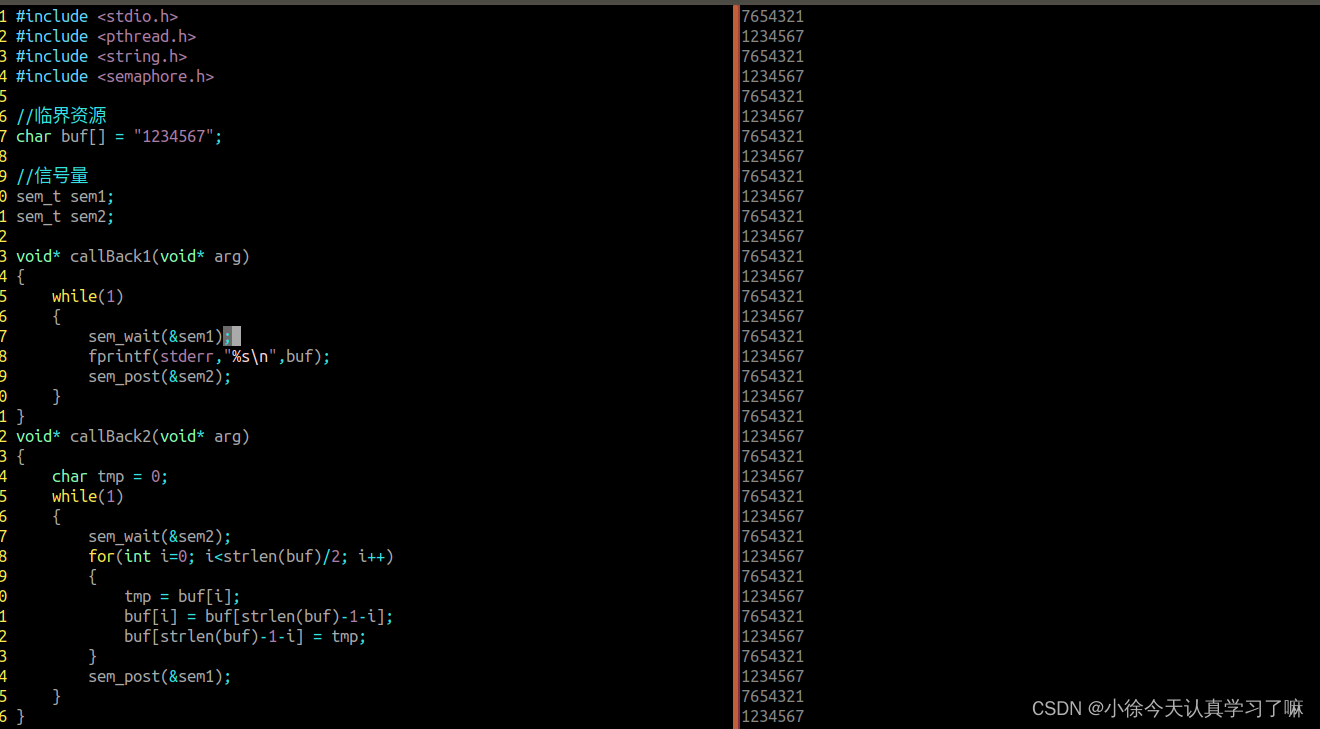
2.创建两个线程,其中一个线程读取文件中的数据,另外一个线程将读取到的内容打印到终端上,类似实现cat一个文件。
cat数据完毕后,要结束两个线程。
提示:先读数据,读到数据后将数据打印到终端上。
#include <stdio.h>
#include <head.h>
#include <pthread.h>
#include <semaphore.h>int fd;
char c;
sem_t sem1;
sem_t sem2;
int res = -1;void *callBack1(void *arg)
{while(1){sem_wait(&sem1);if(read(fd,&c,1) == 0){res = close(fd);sem_post(&sem2);break;}sem_post(&sem2);} printf("线程1\n");pthread_exit(NULL);
}
void *callBack2(void *arg)
{while(1){sem_wait(&sem2);if(res == 0)break;write(1,&c,1);sem_post(&sem1);}printf("线程2\n");pthread_exit(NULL);
}int main(int argc, const char *argv[])
{fd = open("1.txt",O_RDONLY);if(fd < 0){perror("open");return -1;}if(sem_init(&sem1,0,1) < 0){perror("sem_init");return -1;}if(sem_init(&sem2,0,0) < 0){perror("sem_init");return -1;}pthread_t tid1,tid2;if(pthread_create(&tid1,NULL,callBack1,NULL) < 0){fprintf(stderr,"pthread_create falied __%d__",__LINE__);return -1;}if(pthread_create(&tid2,NULL,callBack2,NULL) < 0){fprintf(stderr,"pthread_create falied __%d__",__LINE__);return -1;}pthread_join(tid1,NULL);pthread_join(tid2,NULL);//销毁信号量sem_destroy(&sem1);sem_destroy(&sem2);return 0;
}
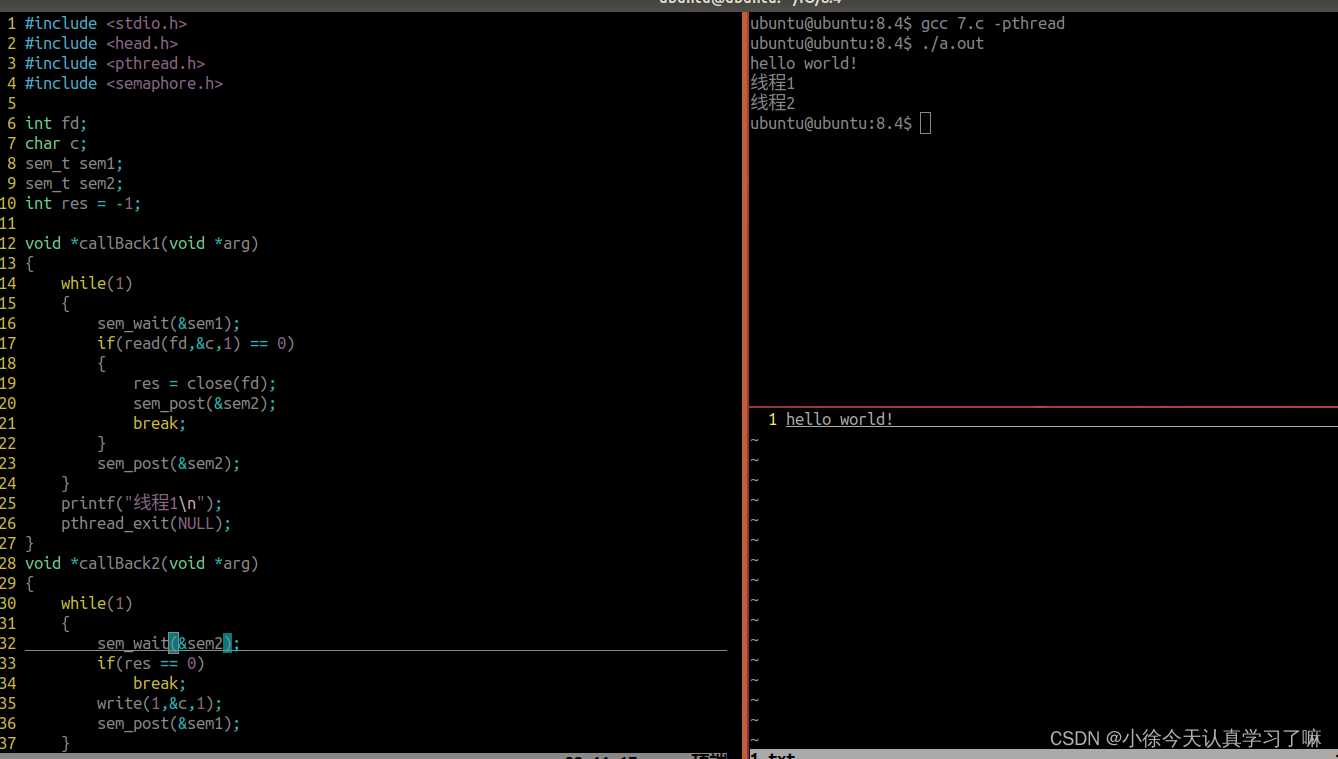
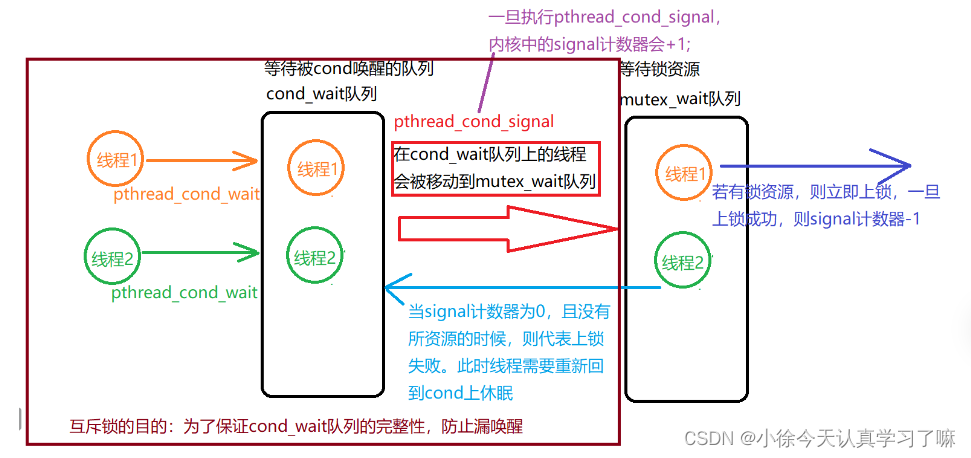
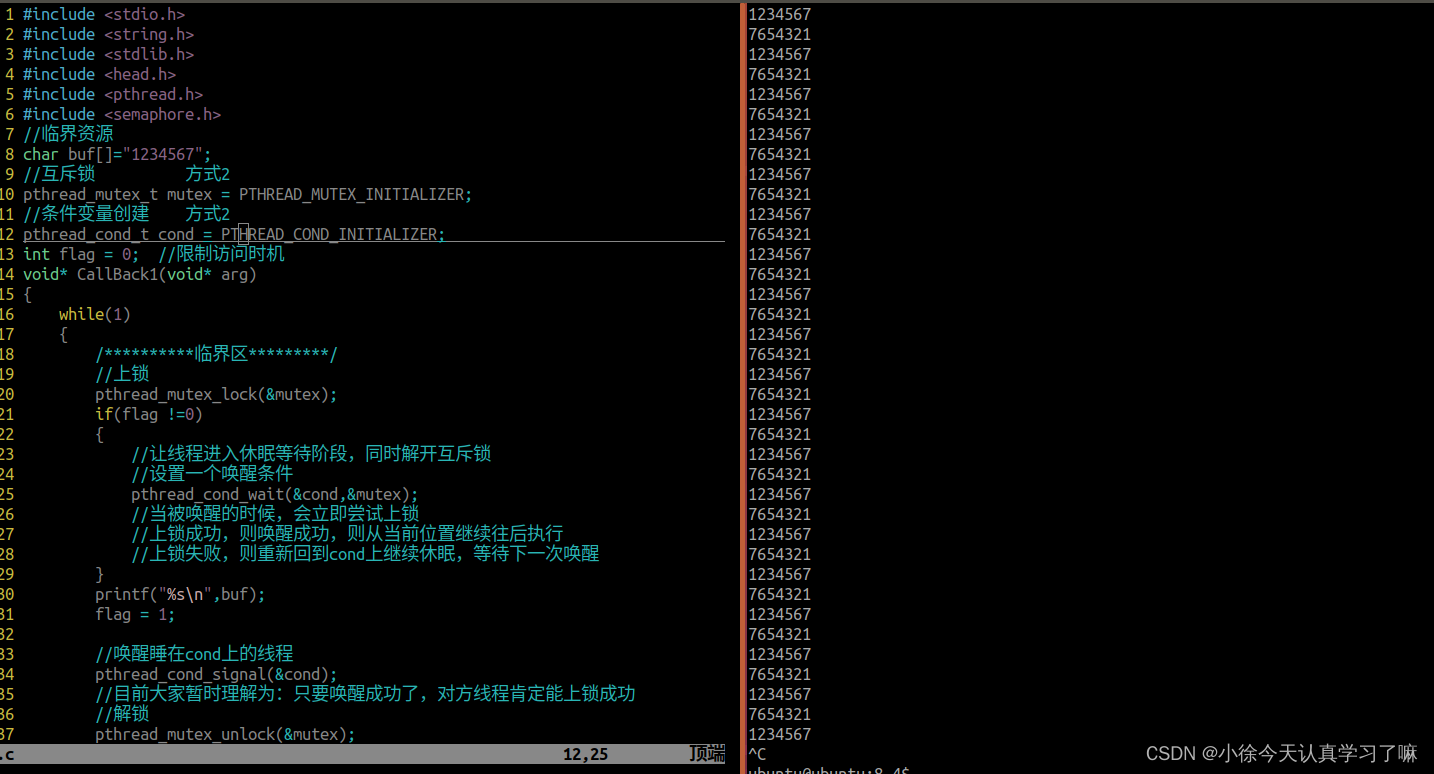
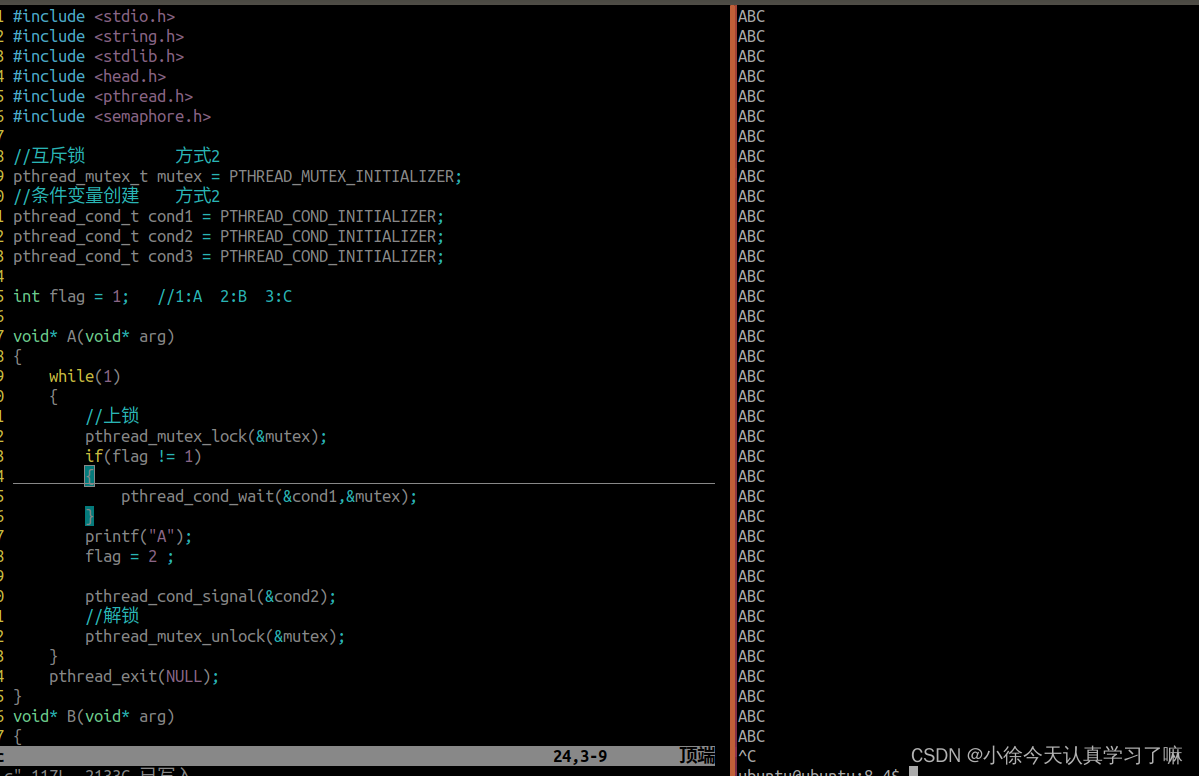









)


)

 和 using)

F1题解)


